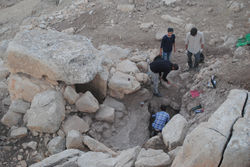Jebel al-Mutawwaq
 |  |  |  |  |
|---|---|---|---|---|
 |
Season 2019
Excavation results of the Spanish-Italian expeditions
During the 2019 excavation season, the areas C-East, D, and EE were investigated.
Area EE
Located on the southern slope of the mountain near the perimeter wall and the gate of the Early Bronze Age I settlement. In this area, Dolmen 11 is being investigated, which, in terms of architectural configuration, is like Dolmen 535 excavated during the previous season: a platform constructed with large, regularly shaped rectangular stone blocks, and a floor made from two flat slabs.
During the excavation of Dolmen 11, a cave, designated as C.1210, was uncovered. This cave was artificially dug into the soft limestone of the mountain and is directly connected to Dolmen 11. The cave has not been fully excavated, but in the entirely excavated chamber, a maximum height of 1.40 meters was recorded. The pottery found inside the cave dates to Early Bronze Age IA; based on this, it is hypothesized that the cave was used for storage and production purposes. Four large tabular scrapers of the same type found elsewhere in the settlement, were also recovered.
Notably, inside C.1210, a terracotta animal figurine was discovered, though its tail and horns were broken. The absence of legs and lack of direct comparisons prevented identification of the animal species or its possible use. Near Dolmen 11, there was a standing stone with a cup mark (CM:1209) in front of it, interpreted as a mortar. Supporting the hypothesis of this being a mortar were the discoveries of five grindstones with pestles, a Cananean blade, and five spindle whorls. These findings suggest that this area, located right next to Dolmen 11, served as a production zone associated with funerary rituals.
Area C-Est
Located in the Great Enclosure, the main gate of the structure (D.1110) and the area of a standing stone within it were investigated. Regarding the gate, exploration extended inward into the Great Enclosure, revealing a structure 8 meters in diameter. Its function is unknown, other than seemingly serving to block the gate after it ceased to be in use. Artifacts allowed both the structure and the gate to be dated to the Early Bronze Age IA. The investigation of the standing stone area uncovered a deposit of jars in situ within an artificially excavated "channel" and a small semicircular room connected to the main wall, W.194. Inside one of the jars, animal bones were discovered.
Area D
The aim of the research in this northern sector was to demonstrate the presence of dwellings and understand their relationship with those in the southern area. This investigation was conducted through geophysical surveys. These analyses allowed for the reconstruction of approximate layouts of buildings yet to be excavated, enabling a comparison with those already studied. In this area, House 400 was discovered, a structure 4 meters wide, with an apsidal layout and an access from the north. Inside the house, tools made of animal bone and basalt, grindstones, and stone loom weights were discovered.



